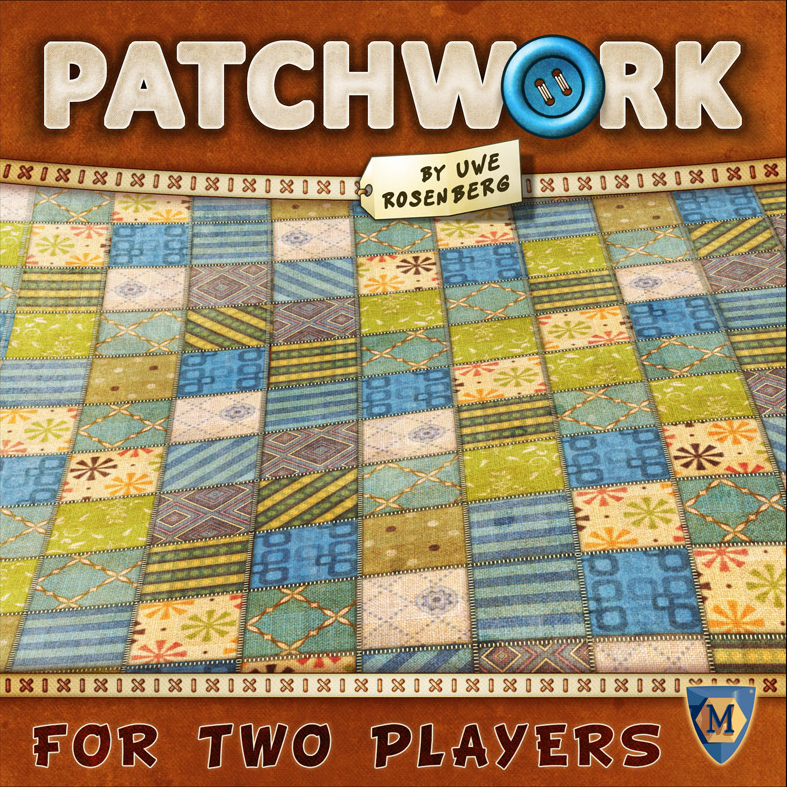Patchwork, for those of you who don’t do a lot of sewing in real life, is the process of piecing together different parts of fabric in order to create clothing or quilts. Now I know what you’re thinking, “Someone made a board game about sewing? Really?” If you bear with me, you’ll soon discover that yes, this game is actually more than meets the eye…sort of like Optimus Prime and his merry band of robots, except with less of Megan Fox bending over cars. Because that’s totally what people wanted to see in a Transformers movie, but I digress…let’s move on to the review, shall we?
Components
The game includes 1 central time board, 2 quilt boards (one per player), 1 neutral token, time tokens, 5 special “leather” patches, 1 special tile, 33 patches, and differently valued button tiles (acts like currency).
Setup & Gameplay
Each player takes a quit board, a time token, and five buttons (as currency). The central time board goes in the middle of the table, with the time tokens placed on the starting space. The special patches go on the marked spaces as well. The regular patches are placed in a circle or oval around the time board. The neutral token is placed right after the 1×2 patch piece (going clockwise).
The game is broken up over a series of turns, though players do not alternate. Instead, the player furthest back on the time track or on top (if they both occupy the same space) goes next. A player can do one of two things on their turn:
1. Advance and receive buttons – The active player takes their time token and moves it to the space directly in front of the other player. The active player then receives one button per space moved.
-OR-
2. Take and place a patch – The active player takes one of the three patches in front of the neutral token (going clockwise) and places the neutral token in its place. The active player then pays (in buttons) for that patch and moves their time token the indicated number of spaces (each patch has a different cost and time value). If a player moves past a special patch, they’ll take it and place it immediately. If a player moves past a button, they’ll receive buttons equal to the number of button icons on the patches on their quilt board. Lastly, they’ll place the patch onto their quilt board in any orientation they’d like.
The first player to fill a 7×7 grid wins the special tile, worth seven points. The game ends when both time tokens have reached the last space on the central time board. Players then take the number of buttons they have left, add the special tile if they have it, then subtract two points for each empty space on their grid. (21 buttons + 7 special tile – 2 empty spaces (-4) = 24). The player with higher score, wins the game!
Editor’s Note: The above doesn’t cover all of the rules found in the manual, but should give you an idea as to how the game is played.
The Review
“Patchwork” can be best described as “deceptively simple” in that the player actions are very easy to perform, yet there’s a lot more going on behind the scenes than one originally thinks. For example, a single patch piece prompts multiple lines of thinking…one of which is how much it’ll cost to buy and place it. Another consideration is how many spaces it’ll bump you up on the time track. Finally, there’s the shape of the piece and how well it’ll fit on your grid in relation to the already existing pieces. Advanced players will also be thinking about the patch pieces that’ll possibly be available to them and their opponents a few turns down the road…after all, you don’t want to set your opponent up with a piece that would work well for them if you can help it.
The quality of the components were good and I had no trouble grasping the content in the manual. I spent more time pouring over the time tracker and deciding what piece I’d do well to pick up based on my current situation. I found that I was torn between focusing on pieces with buttons (for larger periodic payouts) or just simply jumping my time piece ahead for the quick “cash”. Being the first to grab those leather 1×1 patches on the time track can be convenient, though you might have to waste more time than you’d prefer in order to do so. While the theme (sewing) may admittedly be a little less exciting than dungeon sprawling, this is one abstract game that’ll keep you engaged from start to finish…it did in my case. There’s just so much to think about!
Bottom line: I think this is an excellent two player game that almost anyone can get behind, especially if they’re new to abstract or tile-laying games. The theme is most certainly friendly enough, though the game play and light strategy element is what pulled me in. I wished that it included baggies to hold all the button and patch pieces for when you’re done playing…though this is a minor complaint in the grand scheme of things.
Final Verdict: 8/10
—


